The latest read for Cook the Books is Outlaw Cook by by John and Matt Lewis Thorne. (For more interesting reads, go to the Thorne’s newsletter, Simple Cooking.) 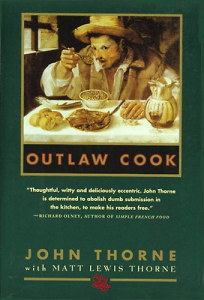 Cook the Books is hosted by Rachel, Debbie and Jo, and is a book club for the
Cook the Books is hosted by Rachel, Debbie and Jo, and is a book club for the avid rabid food enthusiast.
Thorne had me hooked in the preface. As he wrote about the fact that he “couldn’t have too many recipes,” I knew I was reading the words of a kindred spirit. I, too, am a hoarder of recipes, cookbooks, clippings, and I am constantly finding loose envelopes on which I have jotted down a recipe or simply an idea for a dish. One would think with all the technology at my fingertips, I could come up with an organizational plan for my recipes. Instead, I have an empty box that I try to throw in all these loose tidbits (with the exception of a wayward envelope or two).
Along with my lack of organizational skills, I am no time manager and I let out an audible, “AAUUGGHHH,” when I saw Rachel’s reminder for the current Cook the Books club post. I quickly set about looking at the pages I had dog-eared and the notes I had written in the margins of the book.
I also identified with Thorne using cookbooks to “inflate my sense of self as a cook.” Yes, how often I buy a cookbook because it is the next foodie trend. I have Dorie’s and Ottolenghi’s books languishing on the shelf. It is pretentious I know, but the perception put out there is “I must be a great and serious cook. Just look at all the books I own.”
As I read on (and to be honest, because of lack of time and commitment, I skipped around the book quite a bit), Thorne relates that cooking is a process of self-discovery, a personal journey to find one’s palate, style, knowledge and practice in the artistry of food.
The essay that spoke the most to me was “Plowman’s Lunch.”
I was raised a farm girl and have spent time as a “plowman.” Some of the most vivid memories I have are during the harvest. When I was too young to be any significant help in the field, I was relegated to Grandma’s to “help” in the kitchen. We would pack up simple sandwiches and Mason jars full of iced tea to take to the field. There, Dad and Grandpa would stop the combines just long enough to inhale a sandwich and chug down gulps of tea. We would then return to the kitchen to start work on the evening meal, sometimes eaten long after dark, especially if rain were in the forecast. Most generally, this meal would be a casserole of some sort, something that could withstand setting and being reheated as needed. These recipes were hearty and simple: homemade macaroni and cheese (with onions, I might add), hamburger casseroles (often made with Campbell’s soup), smothered steaks, Swedish meatballs, meatloaf. There would also always be a dessert, sometimes pie, but most often home-canned peaches or pears with a drizzle of cream. These were our “Plowman’s” lunches and dinners.
Iced tea again always accompanied these meals, never beer (as Thorne writes of a traditional peasant’s lunch).
As I perused his essay, a couple of other memories washed over me. One was of “Welsh Rabbit” (pg. 43) which we learned to make in home economics class in junior high. We thought it was the weirdest dish we had ever seen (and tasted). I actually think we made it too with Campbell’s tomato soup. (A travesty, I know, but I am sure we did not use ale, port, whiskey or stout.) As I read on about the beverage accompaniment to these simple meals, I was reminded of a high school English teacher (a rebel in his own mind) who taught us that beer was basically liquid bread. (I am sure our parents were thrilled about that tidbit.) And finally, there is a brewery in Hayes, Kansas, the halfway point in our travels to family in Colorado, that is named Lb. They pay homage to immigrant farmers and the “days of the settlers where beer and bread sometimes played interchangeable roles. When in the field, workers couldn’t always stop to eat lunch. So, they drank it. Hence ‘Lb.’ for ‘Liquid Bread’. ” I guess my old English teacher did know what he was talking about. (Imagine that?)
So, forgive my ramblings, but I had many experiences like this as I read Outlaw Cook. Thorne’s prose would lead me on my own mental journey about cooking, food, and comfort.
My inspiration for this recipe comes from “Plowman’s Lunch” but is not a recipe listed in Outlaw Cook. My thoughts were on a bread with beer, onions, and cheese.
“Plowman’s Lunch” Quick Bread
2 T. olive oil (plus more to prepare bread pan)
1 1/2 c. chopped Vidalia onion (about half of a large onion)
8 oz. block of sharp cheddar cheese
6 c. flour
2 t. fine sea salt
2 T. baking powder
2 (12 oz) bottles beer (I used local Choc beer–Waving Wheat–which is another interesting story about immigrants.)
2 T. honeyPreheat oven to 375 degrees.
Heat olive oil in a skillet and saute onions until golden brown (about 10 minutes). Remove from pan and set aside to cool.
While the onions are browning, grate cheese using a fine grater.
In a large mixing bowl, combine flour, salt and baking powder. Use a whisk to combine. Add cheese and toss so that grated pieces are coated with flour and there are no clumps.
Add cooled onions, beer and honey. Mix with a spoon until just combined. Don’t over mix. Put some muscle into it because it is a thick batter.
Place the batter into a large bread pan (or two regular bread pans) coated with olive oil. Use a spatula dipped in water to smooth down the top of the dough.
Place in oven and bake for 45 minutes or until golden and a toothpick comes out clean.
Let cool in pan for 10 minutes. Remove to a wire rack to cool to room temperature.
Slice and serve.
Note: Bitter beer like IPA will make a bitter bread. I liked using the wheat.
We did partake of this bread for a simple weekend lunch. Serve this warm with a pat of butter.
I look forward to delving further into Outlaw Cook and Thorne’s other works like Mouth Wide Open and Serious Pig. There is much food wisdom in his writing:
Maybe what all this means is that we don’t really start learnng how to cook until we begin noticing what gives us pleasure in the kitchen. Cooking is about eating, of course, but it’s also about doing…
Copies of Outlaw Cook seem to be hard to find. When you find one in your travels, snatch it up.
For my other Cook the Book Club posts, you might want to visit the following:
Embarrassment of Mangoes: Fish Taco Salad with Mango Salsa (A WINNER!)
Lunch in Paris: Mint Tea
Garden Spells: Rose Geranium Sugar Cookies
A Homemade Life: Zucchini Noodles with Pesto
Harlot’s Sauce: Greek-Inspired Pizza
The next Cook the Book Club selection will be Roald Dahl’s classic Charlie and the Chocolate Factory. The deadline for blog submissions is March, 26, 2012.
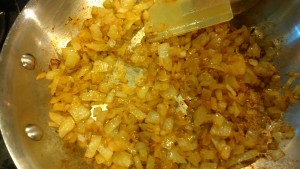


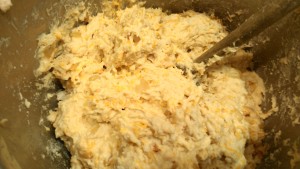
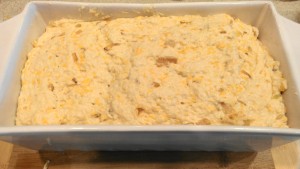
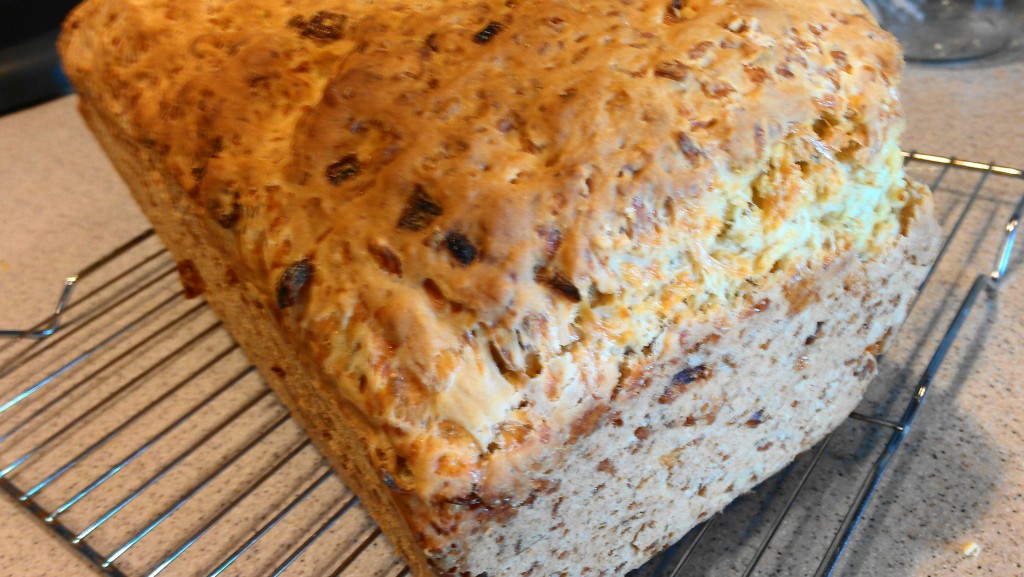
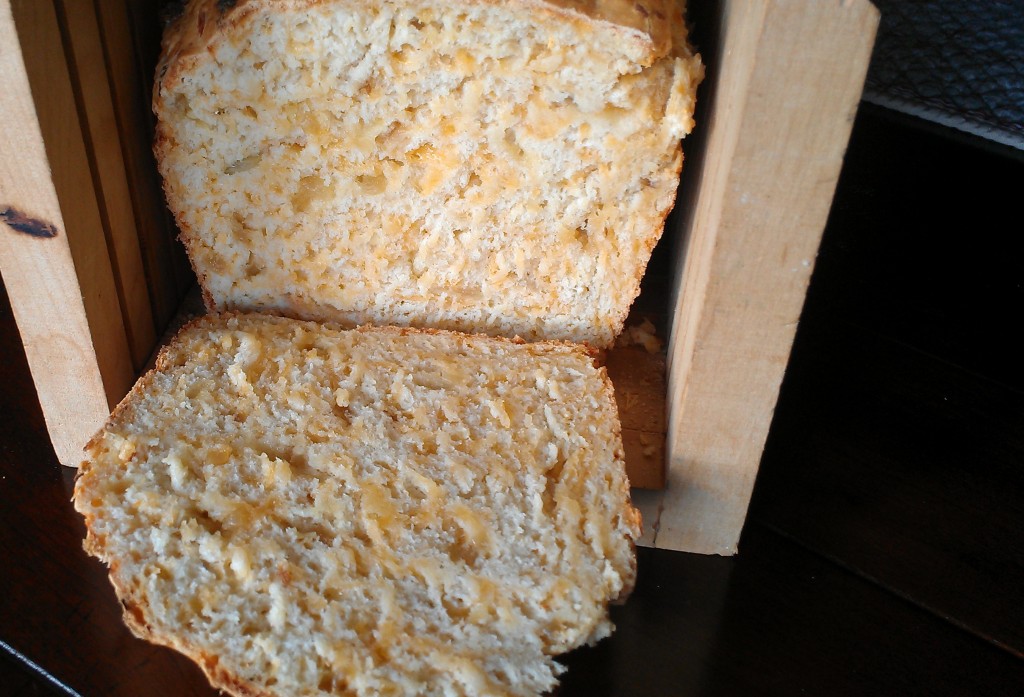


Mmmmmm….your bread looks delish! You should really join FFwD…it will motivate you to use your cookbook. This Friday is an easy one…broth braised potatoes 🙂
Thanks, Liz. It was my intent to join when I bought the book. I will have to revisit it. I love everyone’s FFwD posts every week.
I think I will join you in kindred spiritedness with your words above. I’m so thrilled you enjoyed the book and enjoyed reading all the memories about making meals for your farming family. That plowman’s lunch bread is a brilliant inspiration. Great job for Cook the Books!
Rachel, thanks so much. I enjoyed your CTB post as well. I would have to add The Great Gatsby as one of those classics. I don’t know if it is scarce in the book world but I know that my copy looks worse for wear because of how many times I have read it. I treasure my copy!
I discovered Plowman’s lunches when I lived in England. A simple lunch of bread, ham, cheese, butter and Branston pickle, naturally served with a good pint. I love how you created the whole thing wrapped into one!
Thanks, Rhonda. I would love to try this recipe with a different beer. HMMMM–now you have me wondering about adding a bit of ham (or even better—BACON) to this recipe. What is a Branston pickle?
I LOVE the idea of your “Cook the Books” group…and ploughman’s lunch is a classic for a reason! Filling, delicious and satisfying.
CTB is a lot of fun. It definitely gets the creative juices flowing.
The bread looks amazing! I love book clubs, but it’s hard to keep up with the reading sometimes, isn’t it?
It is very hard to carve out the time. Luckily, CTB always chooses GREAT reads.
Oh my goodness, that last photo with the butter melting into the warm bread with flecks of gorgeous cheese… wow.
Thanks, Kelly. That warm bread was delicious. I gobbled that piece down for lunch right after that photo!
Eliot, your bread looks amazing!!
Thanks, Sydney. Thought your Brussels sprouts recipe was awesome!
Great flavors in this bread, it looks so moist that no butter is needed. Inspiration can be found anywhere, pretty cool you are in a book club that promotes books tied in with food. Delicious post!
This looks so awesome. I’ve made similar beer breads before, however, I don’t think mine has onions in it, and yours seems to have risen far more than mine did.
I’ll need to try this out!
This bread looks amazing. I love how simple it is. Definitely added to my list “to make.” I bet it would be awesome used for Toad in a Hole.
What an awesome bread recipe. Yum!
I can only imagine how wonderful that bread made your house smell!!! I made a beer/onion bread once, but it didn’t have cheese. Yes… this one will work just fine!!!
I had to laugh as I read your post. Our organization skills sound as though they are very similar. My husband is constantly frustrated at my lack of skill, and he does not like my clipped recipes all over my desk. Ah well… I can only tell him that he does eat well!!!
That cheese bread has my mouthwatering – I am an addict for something do cheesy and well bready 😛
I loved your post – made me laugh 😀
Cheers
That bread looks dangerously delicious! Wow!
Life happens (read real job) so I am very behind with keeping up with the comments. Yes the bread smelled wonderful—good and yeasty! I hope you can try this out and experiment with different types of leavening agents (read malt beverage).
I loved his bread chapters as well, and your take on the Plowman’s Lunch sounds and looks fabulous.
Thanks, Claudia.
Hi Eliot — I greatly enjoyed the way you connected what I wrote with your own life and cooking adventures. There’s no greater honor for a food writer than for that to happen. The “ploughman’s loaf” you devised is quite inspired and I’m going to make it myself. (How could anyone resist after seeing that photo of the toast slice topped with a pat of butter!) Readers like you are one of the joys of authoring a book ~ John.
Mr. Thorne—
I am honored by your comment. Thank you for taking the time to stop by.
Wow, very nice bread! I like how you “packaged” your plowman’s lunch.
Nice job for Cook The Books, Eliot! The bread (and butter) look yummy. There were so many inspirational bits throughout the book it was hard to choose just one thing: my head was aswirl with the possibilities.
I agree. I really want to revisit all of the essays again.
Delicious looking bread!!!! And what a great post–I can tell you really took a lot from the book 🙂
Thank you, Danielle. It is a great book!
Yum! I’m making this next week as soon as I get some beer next grocery trip.
I tried it again with an IPA. Would recommend a mild beer (but I am not a beer drinker much).
What a glorious bread. I am off to eat my chicken curry, but I wish I has something like that instead. Great review as always!
I don’t know. Some chicken curry sounds pretty darn good right now. Thanks for the compliment. I am getting ready to revisit Charlie and the Chocolate factory.